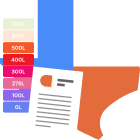Transform Your Teaching
with AI-Powered Worksheets
With ReadTheory’s Instant Worksheet Builder, you can create engaging, grade-appropriate worksheets tailored to your students in minutes. Spark curiosity, save time, and empower critical thinking with AI-powered tools designed for teachers like you.


The Three Branches of the U.S. Government
The government of the United States is split into three 'branches': the Executive, Legislative, and Judicial. The Executive branch is led by the President, who makes important decisions. The Legislative branch includes the Senate and the House of Representatives, who make the nation's laws. The Judicial branch, which is headed by the Supreme Court, ensures that these laws are fair. They all have different roles, but they must work together. This system, known as 'checks and balances', prevents any one branch from becoming too powerful. For instance, if a President wants a new law, Congress must agree to it, and the Supreme Court can judge if it's fair or not. This balance keeps the government running smoothly and ensures that every citizen's voice is heard.
Question 1
Which branch of the government is led by the President?
Executive
Legislative
Judicial
Senate
House of Representatives
Question 2
What is the role of the Judicial branch?
Makes laws
Ensures laws are fair
Led by the President
Makes important decisions
Creates budgets
Question 3
What is the purpose of the 'checks and balances' system?
To give more power to the President
To ensure one branch doesn't become too powerful
To allow the Supreme Court to make laws
To eliminate the Senate
To concentrate power in the hands of the few
Question 4
What must happen for a new law to be established?
The President must agree to it
The Supreme Court must propose it
Congress must agree to it
The Senate must reject it
The House of Representatives must ignore it
Question 5
Which branch of the government includes the Senate and the House of Representatives?
The Judicial branch
The Executive branch
The Legislative branch
The Presidential branch
The Supreme Court branch
 or share via
or share via

Assign the ReadTheory pretest to determine students' reading levels.

Why Teachers Love
Instant Worksheet Builder?

Tailored Content for Every Student
Craft worksheets with passages and multiple-choice questions customized to your chosen topic and grade level, ensuring relevance and engagement.

Save Hours
of Prep Time
Our AI, Lexi, generates complete worksheets—passages, questions, and answers—in minutes, freeing you to focus on teaching, not planning.

Standards-Aligned Learning
Every worksheet is designed to boost reading comprehension and critical thinking, aligning seamlessly with State Standards to help your students shine.
Personalized teaching
for personalized learning
Browse worksheets created and refined by educators using Lexi—your source for inspiration and ready-to-use resources.


ReadTheory is free for Teachers to use.
Join thousands of educators using ReadTheory for free. Sign up today and start creating in just minutes!





